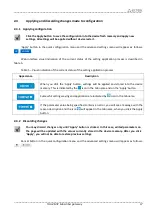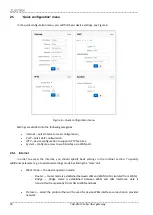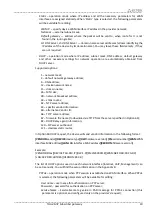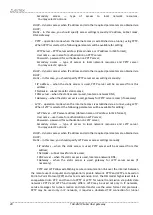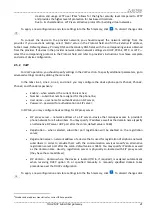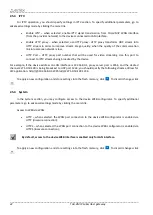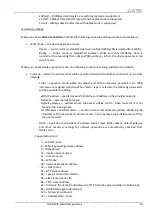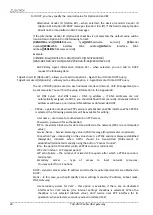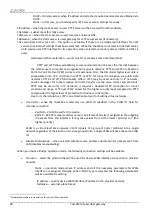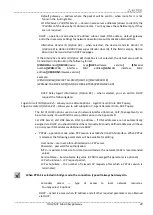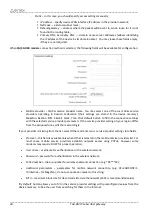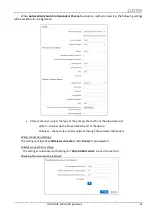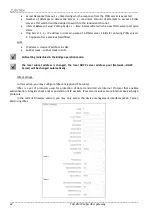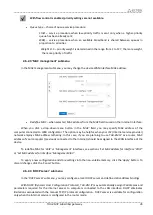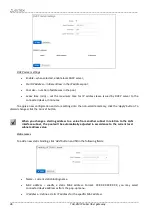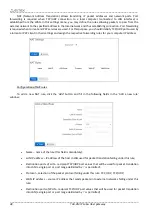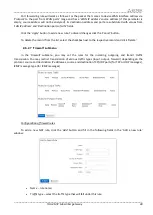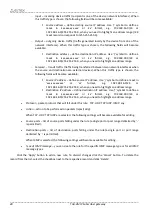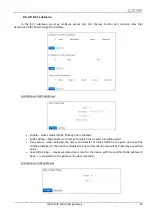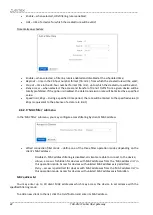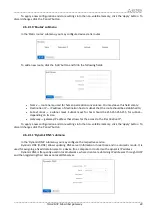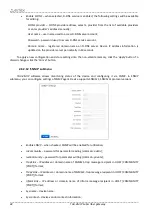
____________________________________________________________________________________
____________________________________________________________________________________
TAU-4M.IP Subscriber gateway
29
Default gateway
— address where the packet will be sent to, when route for it is not
found in the routing table;
1st DNS Server
,
2nd DNS Server
— domain name server addresses (allows to identify the
IP address of the device by its domain name). You may leave these fields empty, if they
are not required.
–
DHCP
– operation mode where IP address, subnet mask, DNS address, default gateway
and other necessary settings for network operation are automatically obtained from
Alternative Vendor ID (Option 60)
– when selected, the device transmits
Vendor ID
(Option 60) in Option 60 DHCP messages (Vendor class ID).
If the field is empty, Option
60 will not be transmitted in DHCP messages.
If the
Alternative Vendor ID (Option 60)
checkbox is not selected, the default value will be
transmitted in Option 60 in the following format:
[VENDOR:
vendor
][DEVICE:
device
type
][HW:
hardware
version
]
[SN:
serial
number
][WAN:
WAN
interface
МАС
address
][LAN:
LAN
interface
MAC
address
][VERSION:
firmware version
]
Example:
[VENDOR:Eltex][DEVICE:TAU-4M.IP][HW:1.0][SN:VI23000118]
[WAN:A8:F9:4B:03:2A:D0][LAN:02:20:80:a8:f9:4b][VERSION:#2.3.0]
DHCP Relay Agent information (Option 82) – when selected, you can add to DHCP
request the following data:
Agent circuit ID (Option 82)
– allows you to add suboption 1 - Agent Circuit ID into DHCP query;
Agent remote ID (Option 82)
– allows you to add suboption 2 - Agent Remote ID into DHCP query.
The list of DHCP options used on each network interface (Internet, VoIP, Management) can
be set manually. You will find the setup information in the Appendix B.
1st DNS Server
,
2nd DNS
Server– DNS Ip address – if DNS addresses are not automatically
assigned via DHCP, you should defined them manually. Manually defined addresses will have
a priority over DNS addresses obtained via DHCP.
PPPoE
– operation mode when PPP session is established on WAN interface. When PPPoE
is selected, the following parameters will be available for editing:
User name
– user name for authorization on PPP server;
Password
– password for authorization;
MTU
– maximum block size for data transmitted via the network (1492 is recommended
value);
Service-Name – Service-Name tag value in PADI message(this parameter is optional);
LCP echo interval
– LCP request period;
LCP echo failure
– the number of missed LCP requests after which a PPPoE session is
terminated;
When PPPoE is selected in bridge mode, the connection type will always be AlwaysOn.
Secondary
access
—
type
of
access
to
local
network
resources.
You may select 2 options:
–
DHCP
– dynamic access when IP address and all other required parameters are obtained
via DHCP;



